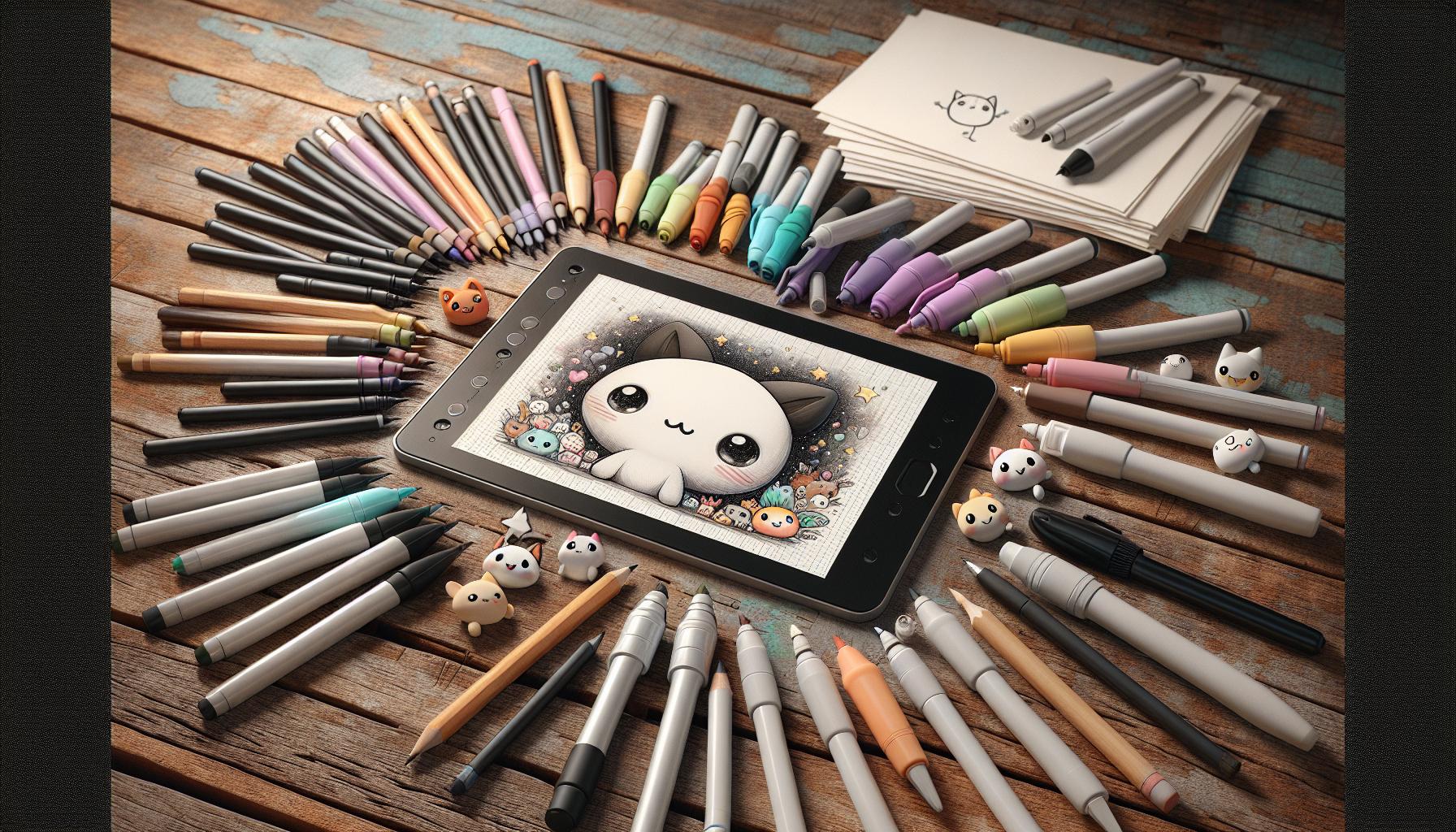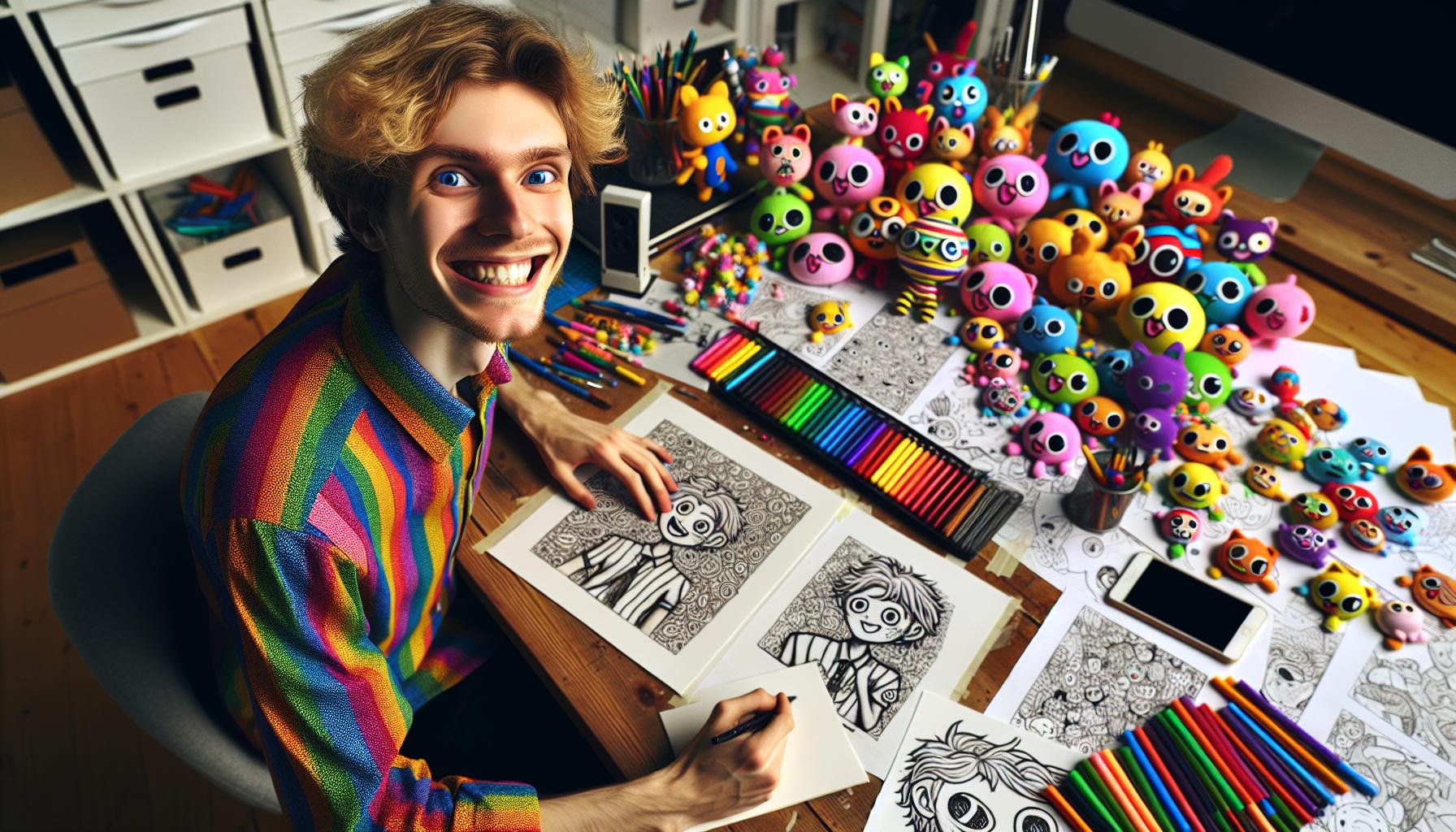Unleashing creativity has never been more adorable than with Kawaii drawings! These cute Japanese-inspired doodles have taken the art world by storm bringing joy to artists of all skill levels. From fluffy animals to smiling food items the charm of Kawaii art lies in its simplicity and heartwarming appeal.
For beginners looking to dive into the world of Kawaii art there’s no need to feel intimidated. The basic principles of Kawaii drawings focus on creating simple shapes with minimal details and adding those signature oversized eyes that make everything look irresistibly cute. Whether you’re doodling in a notebook or creating digital art these easy-to-follow techniques will help transform basic sketches into lovable characters that’ll make anyone smile.
Faciles:avlvwghumek= Dibujos Kawaii
Kawaii drawings represent a distinctive Japanese art style featuring adorable characters with exaggerated features. The term “kawaii” translates to “cute” or “lovable” in Japanese, defining the essence of these illustrations.
Key characteristics of kawaii drawings include:
- Oversized heads with small bodies
- Large expressive eyes with sparkles or highlights
- Minimalist facial features like tiny mouths or rosy cheeks
- Soft rounded shapes without sharp angles
- Pastel color palettes with gentle tones
Common subjects in kawaii art encompass:
- Animals: cats, pandas, bunnies
- Food items: sushi rolls, cupcakes, fruits
- Everyday objects: school supplies, household items
- Fantasy creatures: unicorns, dragons, mermaids
The artistic elements focus on:
| Element | Description |
|---|---|
| Proportions | 1:2 head-to-body ratio |
| Lines | Smooth curved strokes |
| Shading | Simple gradients or flat colors |
| Details | Minimal decorative elements |
Kawaii drawings originated in 1970s Japan through manga illustrations teenage girls created. Today’s kawaii art appears across multiple platforms:
- Social media platforms
- Digital art communities
- Merchandise design
- Educational materials
- Personal stationery
This artistic style emphasizes simplicity through basic geometric shapes transformed into endearing characters. Artists combine circles squares triangles to create recognizable forms with childlike charm universal appeal.
Essential Tools and Materials

Creating Kawaii drawings requires specific tools that enhance the cute aesthetic while maintaining simplicity in execution. The right materials contribute significantly to achieving the signature rounded edges and smooth lines characteristic of this adorable art style.
Basic Art Supplies
- Mechanical pencils (0.5mm or 0.7mm) produce precise initial sketches
- Fine-point black markers create clean outlines
- Colored markers in pastel shades add soft kawaii tones
- White gel pens highlight eye sparkles or blush marks
- Drawing paper with smooth texture (70-80 lb weight) prevents ink bleeding
- Erasers in different sizes remove sketch lines without damaging paper
- Ruler assists in creating symmetrical shapes
- Circular templates help form perfect circles for eyes and heads
- Drawing tablets (Wacom Intuos Pro or XP-Pen) offer pressure sensitivity
- iPad Pro with Apple Pencil enables portable digital creation
- Procreate app includes brush customization for kawaii effects
- Clip Studio Paint provides specialized manga tools
- Adobe Illustrator creates scalable vector kawaii characters
- Free software options include Krita or MediBang Paint
- Cloud storage services backup artwork automatically
- Screen recording apps capture drawing process for tutorials
Simple Kawaii Characters

Creating adorable Kawaii characters starts with mastering fundamental shapes combined with expressive features. These characters transform basic geometric forms into lovable personalities through strategic placement of facial elements.
Animal Characters
Simple Kawaii animal characters feature rounded shapes with oversized heads measuring 2-3 times larger than their bodies. Popular animal designs include:
- Cats with triangular ears positioned symmetrically
- Rabbits featuring long oval ears drooping downward
- Bears incorporating circular ears on rounded heads
- Pandas with distinctive black patches around large eyes
- Hamsters with small circular ears placed high on the head
The facial features follow specific proportions:
| Feature | Size Ratio |
|---|---|
| Eyes | 1/3 of face width |
| Nose | 1/6 of face width |
| Mouth | 1/4 of face width |
Food Characters
Kawaii food characters transform everyday edibles into cute companions through anthropomorphic features. Essential elements include:
- Sushi rolls with rosy cheeks sitting atop oval shapes
- Ice cream cones displaying heart-shaped mouths
- Cupcakes wearing tiny crown decorations
- Coffee cups with steam swirls forming hair
- Cookies featuring star-shaped sparkles
| Element | Design Approach |
|---|---|
| Eyes | Placed on upper third |
| Limbs | Stick arms with rounded ends |
| Expression | Small curved smile |
| Blush | Pink circles below eyes |
Step-by-Step Drawing Techniques

Creating Kawaii drawings follows a systematic approach that builds from simple geometric shapes to adorable finished characters. These techniques break down complex designs into manageable steps for artists of all skill levels.
Basic Shapes Method
Start with basic geometric shapes as building blocks for Kawaii characters. Draw circles for heads using a 2:1 ratio compared to the body size. Create smaller circles for ears, paws, or accessories. Add ovals for bodies, rectangles for limbs, and triangles for distinctive features like animal ears or decorative elements. Position these shapes in a balanced composition, leaving space for facial features. A typical Kawaii character consists of:
- One large circle (head) measuring 2-3 inches
- One medium oval (body) measuring 1-1.5 inches
- Two small circles (ears/paws) measuring 0.5 inches each
- Four thin rectangles (limbs) measuring 1 inch long
- Two oversized eyes with highlights
- Small U-shaped mouth
- Rosy circles on both cheeks
- Tiny curved eyebrows for expression
- Simple accessories like bows or flowers
Tips for Creating Adorable Expressions
Facial expressions define the personality of Kawaii characters through strategic placement of simple elements. Creating expressive eyes enhances character appeal by varying their size between 1/4 to 1/3 of the face width. Positioning eyes slightly above the center of the face creates balance while maintaining the signature Kawaii look.
Basic expressions incorporate these key elements:
- Draw sparkles in eyes using small white circles
- Add curved eyelashes for feminine characters
- Place small rosy circles on cheeks at a 45-degree angle
- Create tiny U-shaped or heart-shaped mouths below the eyes
Advanced emotional variations include:
- Sleepy faces with curved line eyes
- Excited expressions with star-shaped sparkles
- Crying faces with teardrop shapes
- Surprised looks with circular O-shaped mouths
Eye style combinations enhance character uniqueness:
| Eye Type | Size Ratio | Key Features |
|---|---|---|
| Classic | 1:3 face width | Large pupils centered |
| Chibi | 1:2 face width | Extra white highlights |
| Minimal | 1:4 face width | Simple dot pupils |
Eyebrow placement affects emotional depth:
- Raised inner corners express worry
- Straight lines show determination
- Gentle curves indicate happiness
- Angled lines demonstrate anger
- Add faint freckles below eyes
- Include tiny fangs for playful characters
- Draw subtle whisker marks
- Place heart symbols near expressions
Color and Shading Basics
Color selection enhances the adorable appeal of Kawaii characters through strategic use of pastel palettes and gentle shading techniques. Traditional Kawaii art employs soft, muted colors like baby pink, mint green, lavender purple and sky blue as primary choices.
Three essential color zones define Kawaii character design:
- Base colors occupy 60% of the character using light pastel tones
- Accent colors take up 30% using slightly darker complementary shades
- Highlight colors fill 10% using pure white or light yellow spots
Simple shading techniques create depth while maintaining the cute aesthetic:
- Add shadows using a slightly darker tone of the base color
- Place soft shadows under the chin and along curved edges
- Include white highlights in the eyes and on rounded surfaces
- Create blush spots using light pink circles at 20% opacity
Color combinations for popular Kawaii themes:
| Theme | Base Color | Accent Color | Highlight |
|---|---|---|---|
| Bears | Light Brown | Dark Brown | White |
| Cats | Light Grey | Pink/Purple | Pure White |
| Desserts | Pastel Pink | Light Yellow | White |
| Plants | Mint Green | Sage Green | Light Yellow |
Digital coloring incorporates subtle gradients by:
- Using the multiply blend mode at 15-20% opacity
- Adding selective blur effects on shadow edges
- Implementing cell shading with soft transitions
- Creating depth through overlapping transparent layers
The finished character maintains simple color blocks with minimal texture details to preserve the signature Kawaii style’s clean appearance.
Kawaii drawings offer a delightful blend of simplicity and charm that’s accessible to artists at every skill level. Through basic shapes minimalist details and signature features like oversized eyes artists can create endearing characters that capture hearts worldwide.
The style’s versatility extends from traditional pencil sketches to digital art allowing creators to express their creativity across various mediums. Whether drawing adorable animals or giving personality to everyday objects the Kawaii art style continues to evolve while maintaining its core principle of cuteness.
Armed with the right tools techniques and understanding of Kawaii principles anyone can start their journey into this heartwarming art form. It’s a style that proves great art doesn’t need to be complex to make people smile.

